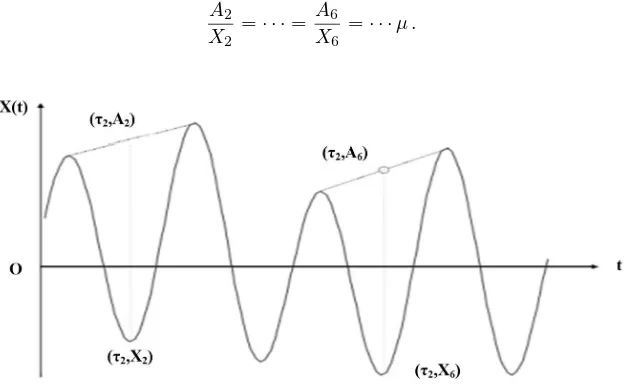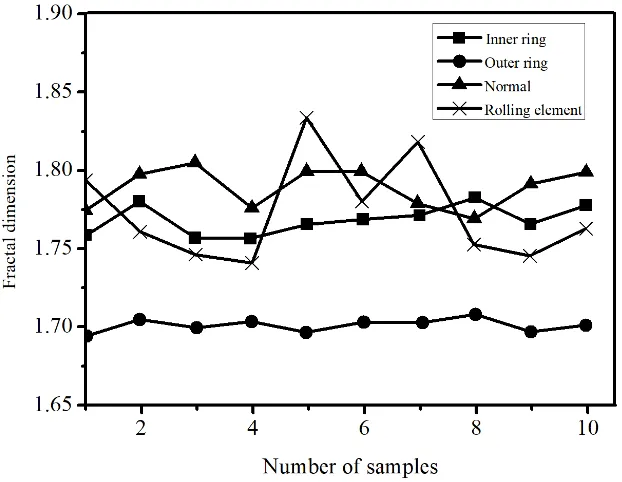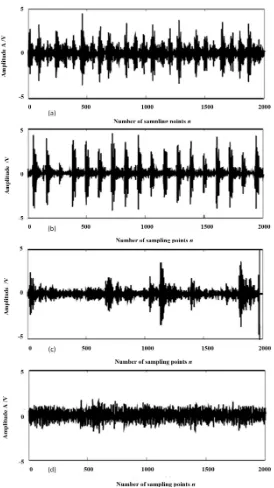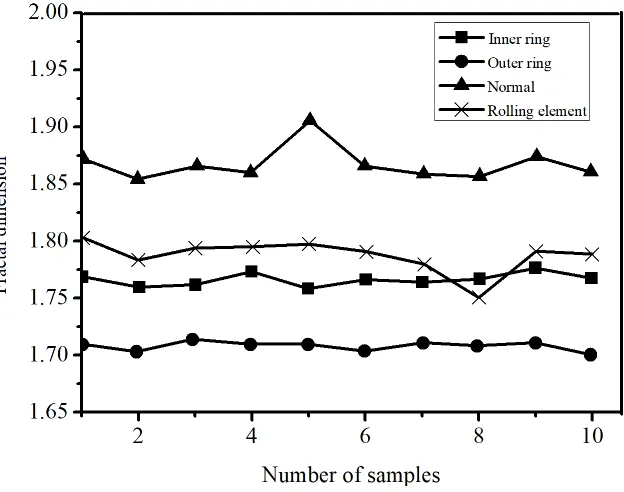Fault diagnosis methods of rotating
machinery based on mathematical
morphology
Jumei Zhang
1Abstract. To make a fault diagnosis of rotating machinery, it is necessary to use the Local Characteristic-scale Decomposition (LCD) to remove the noise before the fractal method. The major reason is that the fractal method is sensitive to mechanical noise. LCD and mathematical morphology method are combined for the diagnosis of mechanical failure, and in this ways, more accurate results can be obtained than that under the box dimensions. In addition, the morphological fractal dimension is used to calculate the fractal dimension of the main component, and the degree of discrimination of each state can be clearly depicted by curve description. And the results showed that the fault state of rolling bearing can be effectively identified and fault diagnosis can be realized. At last, it is concluded that the method based on LCD decomposition and morphology fractal dimension can successfully do the fault diagnosis, which has great application value and good prospect.
Key words. Mathematical morphology, rotating machinery, LCD, fault diagnosis.
1. Introduction
With the development of economic globalization and science and technology, peo-ple had a higher request in the stable and efficient operation of the machinery and equipment in industrial. More and more attention had been paid to the equipment fault diagnosis technology. Rolling bearings are one of the most commonly compo-nents used in mechanical equipment, but they are also particularly vulnerable to damage, which is detrimental to the life of the entire system and normal produc-tion. So, it is necessary to detect and diagnose the failure state of machinery and equipment bearing.
In 1991, Koskinen extended the traditional mathematical morphology operator, and proposed soft mathematical morphology. Soft mathematical morphology means to replace the maximum and minimum operation in the traditional mathematical morphology as weighted ordering statistics. Its structure elements include two parts:
1
Weinan Normal University, Weinan, Shaanxi, 710000, China
hardcore and soft boundary [1]. In 1990s, Sinha and other scholars introduced fuzzy theory into traditional mathematical morphology, and put forward fuzzy mathemat-ical morphology. It used membership function to achieve the operation between structure operator and fuzzy images. As a result, compared with traditional mathe-matical morphology, fuzzy mathemathe-matical morphology has stronger noise suppression capability. At present, application of morphology based on single scale structure element is widely studied. Zhang Lijun used generator signal for the filtering pro-cessing, and then he applied morphology non-sampling wavelet for the rotor wave processing and Shen Lu made use of morphology wavelet and morphology non-sampling to make filtering processing of gearing and rolling, respectively [2]. All of these studies laid a foundation for the further study of mathematical morphology. Mechanical fault diagnosis is an actually signal processing. The fault signal is typi-cally non-linearity and non-stationarity. The fractal dimension of the mathematical morphology can effectively analyze and characterize the nonlinear behavior of the fault signal. However, the measured bearing vibration signal often contains a lot of system background noise. Because the mathematical morphology fractal dimension is very sensitive to noise, so the measured signal must be denoised to get the ac-curate fractal dimension, and the traditional linear filter is usually not competent [3]. A new adaptive time-frequency analysis method—Local Characteristic-Scale Decomposition (LCD) is proposed, which can decompose the vibration signal into a single rotation component with physical meaning at instantaneous frequency. In this paper, the LCD method is combined with the fractal dimension of the morphol-ogy, and the vibration signal is decomposed by the LCD. The components of the main characteristic frequency are used as the fault signals to be analyzed. The mor-phological fractal dimension is used to calculate the fractal dimension of the main component, and the degree of discrimination of each state can be clearly depicted by curve description, which can effectively identify the fault state of rolling bearing and realize the fault diagnosis of rolling bearing.
2. Materials and methods
2.1. Mathematical morphology
The basic idea of using mathematical morphology to measure the complexity of the nonlinearity of vibration signals at different scales is that the results of covering the one-dimensional vibration signals with planar setBin the process of dealing with one-dimensional fault signals are regarded as one-dimensional structural elementsg to detect the signal, which is an equivalent method, in which the structural element is the upper bound of the planar set B. Based on the above-mentioned idea, the concrete method steps are as follows [4]: the one-dimensional discrete vibration signal f(n) (n= 0,1,· · · , N), g(m) is the one-dimensional unit structure element defined on G = {0,1,2,· · ·, M −1}. One-dimensional morphology corrosion and expansion are carried out to measured signal, and the scale ε = 0,1,2,· · · , εmax
2.2. Analysis of simulation signal
In order to verify the effectiveness of fractal dimension estimation method based on mathematical morphology, Weierstrass cosine function (WCF) is used as the fractal signal, which is defined as [5]:
WH(t) =
In the formula, γ >1. WCF is a continuous but not differentiable signal, and the fractal dimension of WH is D = 2−H in theory. The sampling frequency of
the simulation signal is 1024 Hz, the number of sampling points is 2048, and the parameters are set to γ = 5and k = 20 [6–7]. Table 1 shows the WCF signals of three different dimensions (D= 1.4,1.6,1.8).
At present, the Box-counting method is the most widely used signal estimation method, but because the box dimension divides the grid regularly, there is a problem that the fractal dimension estimation is inaccurate. However, the mathematical mor-phology is not affected by these factors, and the calculation results are more accurate [8]. Table 1 is the result of using box counting and fractal dimension estimation to deal with the signal. From Table 1, it can be seen that the fractal dimension of the box counting method is generally low, the error is larger than the mathematical morphology, and the morphology is more accurate, and the computational efficiency of mathematical morphology is higher than the box dimension.
Table 1. Fractal dimension estimation of WCF signal
Methods Actual value D= 1.4 D= 1.6 D= 1.8
Box-counting method Estimated value 1.3497 1.4997 1.6553 Relative error 3.59 % 6.26 % 8.04 % Morphological method Estimated value 1.4386 1.6200 1.8076 Relative error 1.97 % 1.25 % 0.42 %
The WCF signal was morphologically covered with structural elements of sizes 32 and 64. Figure 1 shows the expansive corrosion results of W0.4(t)at scales 32
and 64.
2.3. LCD decomposition method
extreme points [9]. Therefore, the straight line
Fig. 1. Double logarithmic curve ofW0 .2(
t)
lk
y=Xk+
Xk+2−Xk τk+2−τk
(t−τk)
is determined by any two adjacent extremums (maximum or minimum)(τk, Xk)and
(τk+2, Xk+2) in the data segment, the ratio of the value Ak+1 of this line in τk+1
and the function value at this point are unchanged, as shown in Fig. 2.
A2
X2
=· · ·= A6
X6
=· · ·µ . (2)
In the simulation signal, µ may not change, but in the actual signal, its value must not be so stable, so it can be changed in a certain range of permission.
The general form is [10]:
The following signals are used to investigate the decomposing effect of the LCD:
x(t) =x1(t) +x2(t) = [1 + 0.5 cos (20πt)] sin 200πt+ 200t 2
+ sin (40πt). (5)
The simulation signal is composed of an amplitude modulation and frequency modulation signal and a sinusoidal signal.
From the decomposition results of the LCD, it can be seen that this method can decompose the frequency components in the simulation signal very well. CISC3 has a small fluctuation after processing the end effect by the extension method, and the processing result is ideal. The results show that LCD is an effective and feasible decomposition method.
In the case of adaptive time-frequency analysis, such as Empirical Mode Decom-position (EMD) and Local Mean DecomDecom-position (LMD), these methods only give their components with the physical meaning [11]. The conditions that the intrinsic mode function (IMF) component EMD definite by EMD or the PF component in LMD need to meet are the sufficient conditions of instantaneous frequency with the physical meaning, but not a necessary condition, that is, as long as certain conditions are met, a single component signal can have physical significance. In addition, the cubic spline function is used to deal with the end-effect in the EMD method, which often has over-envelope, under-envelope phenomenon in the formation of the upper and lower envelopes, and the mode aliasing is serious. However, the LMD method has more end-effects than the EMD method, and the range of the LMD method is small, but the LMD algorithm has its own limitations [12]. In the decomposition of LMD algorithm, it uses the moving average algorithm to calculate the local mean function and local envelope function, while the moving average algorithm is a cycle of multiple iterations, so the calculation is very large. For these reasons, the compo-nents defined by EMD and LMD often result in unreliable methods. Therefore, this paper combines a new instantaneous frequency with physical meaning of the decom-position method LCD with the morphology. Experiments show that this method is effective.
fault whose bearing model is 6205-2RS JEM SKF in United States West Reserve University [13]. The four failure types of the rolling bearing failure in normal test platform, rolling element failure, inner ring failure and outer ring failure are used.
It can be seen from Fig. 3 that when the vibration signal is not denoised, the fractal dimension of the rolling element fault has two sudden ups and down at the position of sample 4 to 8, which cause the interference by overlapping with the curve of the normal state and the inner fault state. The curve of fractal dimension overlap twice in inner-circle fault and in the normal state, which makes the fault state unrecognizable. As the LCD method can decompose the original signal from high frequency to low frequency into several components, the high frequency component is often the best to reflect the fault feature information [14]. Therefore, usually the first component after the characteristic scale decomposition is calculated, and the vibration state of each failure can be effectively discriminate. Figure 3 is the first intrinsic component of the signal corresponding to Fig. 4.
Fig. 3. Morphology fractal dimension of bearing faults signal
Fig. 4. The first component of the signal of four bearing fault conditions: (a)–first component of the rolling bearing inner ring, (b)–first component of the rolling bearing outer ring, (c)–first component of the rolling element of rolling bearing,
in normal state, and it is similar to the random signals in probability distribution, the randomness is equivalent to the instability in various states, which also coincides with the definition of the dimension in the mathematical morphology. While the inner ring fault and the rolling element failure are fault signals with obvious impact, so their dimensions are relatively small, but there is not much difference between the dimensions. While the impacts to the outer ring are relatively large, and the features are relatively obvious, so the dimension is smaller than the other fault types [16]. Although the fractal curves of the inner ring and the rolling element has once intersected, this does not affect the accurate discrimination of them. The fractal dimension of mathematical morphology based on LCD can distinguish the four states better. The experimental results show the effectiveness and feasibility of the method.
Fig. 5. The first CISC morphology fractal dimension of bearing fault signals
4. Conclusion
method, the ISC component of the characteristic fault signal is obtained. The fractal dimension of each ISC component is calculated and used as the characteristic pa-rameter to judge the state. At last, the normal bearing, rolling element failure, inner ring fault and outer ring fault are analyzed. The results show that the method based on LCD decomposition and morphology fractal dimension can effectively realize the diagnosis of rolling bearing fault state.
References
[1] A. J. Hu, G. J. Tang, L. S. AnDenoising technique for vibration signals of rotating machinery based on mathematical morphology filter. Chinese Journal of Mechanical
Engineering42 (2006), No. 4, 127–130.
[2] H. Li, R. Wang, S. Cao, Y. Chen, W. Huang: A method for low-frequency noise suppression based on mathematical morphology in microseismic monitoring.
Geo-physics81 (2016), No. 3, V159–V167.
[3] S. Sumijan, S. Madenda, J. Harlan, E. P. Wibowo: Hybrids Otsu method, feature region and mathematical morphology for calculating volume hemorrhage brain on CT-Scan image and 3D reconstruction. TELKOMNIKA Telecommunication, Computing,
Electronics and Control15 (2017), No. 1, 283–291.
[4] D. Legland, I. Arganda-Carreras, P. Andrey: MorphoLibJ: Integrated library and plugins for mathematical morphology with Image. Journal Bioinformatics 32
(2016), No. 22, 3532–3534.
[5] B. Bouraoui, C. Ronse, J. Baruthio, N. Passat, P. Germain: 3D segmentation of coronary arteries based on advanced mathematical morphology techniques.
Comput-erized Medical Imaging and Graphics34 (2010), No. 5, 377–387.
[6] Y. Li, J. Zhao, B. Mo: Small target segmentation algorithm based on wavelet trans-form and mathematics morphologic. International Journal of Electronics and Electrical
Engineering1 (2013), No. 2, 76–79.
[7] T. Han, D. Jiang, X. Zhang, Y. Sun: Intelligent diagnosis method for rotating ma-chinery using dictionary learning and singular value decomposition. Sensors (Basel)17
(2017), No. 4, paper 689.
[8] J. Atif, C. Hudelot, I. Bloch: Explanatory reasoning for image understanding us-ing formal concept analysis and description logics. IEEE Transactions on Systems,
Man, and Cybernetics: Systems44 (2014), No. 5, 552–570.
[9] C. Lu, Y. Wang, M. Ragulskis, Y. Cheng: Fault diagnosis for rotating machinery: A method based on image processing. PLoS ONE11 (2016), No. 10, e0164111. [10] T. Xu, G. Wang, H. Wang, T. Yuan, Z. Zhong: Gap measurement of point
ma-chine using adaptive wavelet threshold and mathematical morphology. Sensors (Basel)
16, (2016), No. 12, e2006.
[11] A. Hu, L. Xiang, G. Tang, Y. Du: Fault feature extracting method of rotating ma-chinery based on mathematical morphology. Chinese Journal of Mechanical Engineering
47 (2011), No. 23, 92–96.
[12] L. Shen, X. J. Zhou, W. B. Zhang, Z. G. Zhang: Denoising for vibration signals of a rotating machinery based on generalized mathematical morphological filter. Journal
of Vibration and Shock28 (2009), No. 9, 70–73.
[13] S. Wang, J. Zhang, Y. Li, S. Zhang: Rotating machinery fault diagnosis based on mathematical morphology and fuzzy clustering. Chinese Journal of Scientific
Instru-ment33 (2012), No. 5, 1055–1061.
[15] J. Xiong, Q. Zhang, Z. Peng: A diagnosis method for rotation machinery faults based on dimensionless indexes combined with K-nearest neighbor algorithm. Mathe-matical Problems in Engineering (2015), No. 4, 1–9.
[16] R. Jia, X. Y. Wang, Z. H. Cai, L. Zhang, X. Q. Luo: The Hilbet-Huang transform based on least squares support regression machine and its application in the fault di-agnosis of hydroelectric generation unit. Proceedings of the CSEE26 (2006), No. 22, 128–133.



